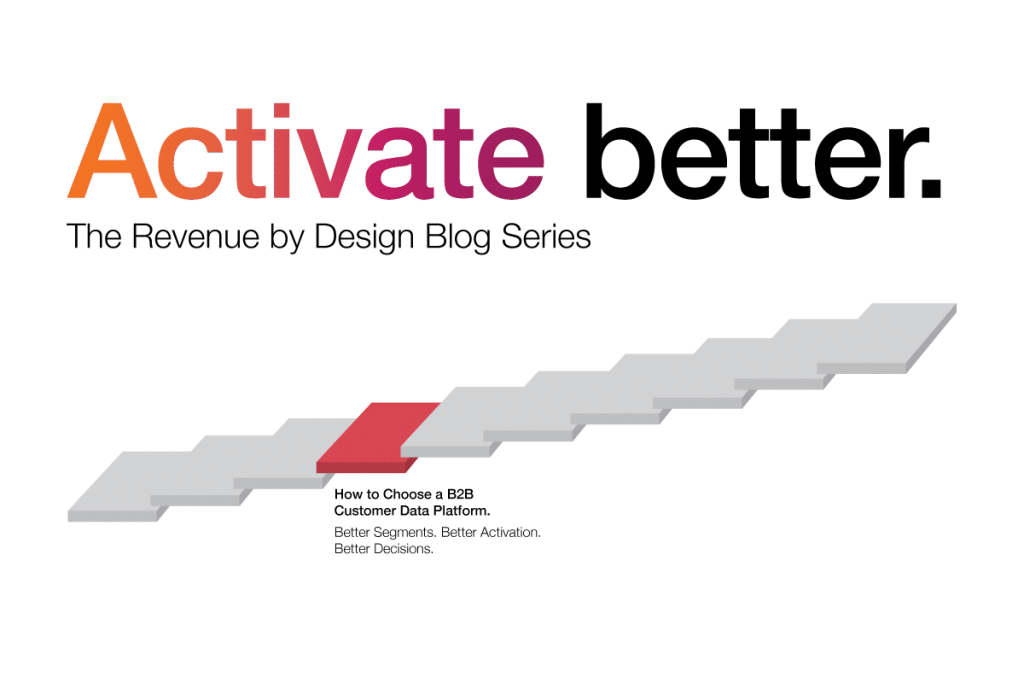If someone is interested in your product or service, is it necessarily true that they will convert into a paying customer in the future? Does a higher level of interest translate into higher odds of sales conversion? How do we know if the way we are measuring and assessing their interest is accurate? Is that interest based on accurate, up-to-date data? Do they need your product now? Are they the right person within the company to pursue? Do they likely have the budget and authority to fund your product? Is their company aligned with your Ideal Customer Profile (ICP)? Simply put, are you confident that the data and signals you have validate that a lead is truly ready, able, and eager to buy your product or service? These are questions that need to be answered in order to classify a lead as a “quality lead.”
When it comes to lead generation, we often focus on hitting KPIs and generating as many leads as possible – forgetting that quantity doesn’t equal quality. At the end of the day, the quality of those leads is the factor that most affects the bottom line of your business. You won’t grow your business with low quality leads. Consider the amount of time, money and effort that goes into pursuing every single lead you generate. And the odds are against quality. According to lead generation statistics, only about 20% of B2B leads become sales-ready!
However, by accurately and proactively identifying those 20% that are high-quality leads in advance, we can cut an enormous amount of waste from our sales and marketing process. This is where AI scoring models come into play. A scoring model analyzes thousands of account or lead buying signals (demographics, technographics, firmographics, etc) to automatically score and categorize how well they match up with the Ideal Customer Profile. Scoring models are primarily used to assist sales and marketing teams in identifying the best leads for follow up, responding to them appropriately, and increasing the rate at which they become customers by prioritizing the leads that are most likely to buy. With scoring models, we can also analyze our Cost Per Lead (CPL) and determine what value to assign each lead based on their actual degree of compatibility with our products or services. Using multiple scoring models in conjunction with predictive models is a particularly efficient way of effectively identifying and prioritizing closeable business interest. Let’s dive into how we can throw out most of our leads by applying AI models to filter them by the dimensions of a “quality lead.”
While the specific criteria for a quality B2B lead may vary depending on the industry and business goals, there are several dimensions to consider in combination that indicate the potential for a lead to be considered “quality” or “high quality.”
- 1. Relevance
- 2. Budget and resources
- 3. Fit with your value proposition
- 4. Need and pain points
- 5. Timing
- 6. Decision-making authority
- 7. Engagement and interest
- 8. Relationship potential
A quality B2B lead should first and foremost be evaluated, and filtered, by its relevance to your business and alignment with your target market. They often belong to the industries or segments where your product or service has enjoyed success. The more closely a lead matches your ideal customer profile, the higher the likelihood of conversion. It’s also essential to determine whether a lead has the financial resources to afford your products or services. A quality B2B lead should perceive the unique value and differentiation your business brings, recognizing how your offerings can solve their problems more effectively than alternative solutions. This can be determined by a “fit” or propensity score, which indicates how well the company matches your Ideal Customer Profile (ICP) through firmographic and technographic comparative analysis. A strong fit score can signal a 2-12X increase in conversion rates. This is the first model that should be applied to your individual lead to determine if it’s even the right type of company for your product. If the lead has a low fit score, you should throw it out! They’re more than likely not going to buy your product (even if your intent model says otherwise). Only after we’ve filtered for leads with a high company fit score should we take intent scores into account.
Your value proposition should resonate with the lead’s specific requirements and align with their expectations. Simply put, are they interested in your type of product or service? A quality B2B lead should perceive the unique value and differentiation your business brings, recognizing how your offerings can solve their problems more effectively than alternative solutions. A quality B2B lead should have a genuine need for your products or services. They should be facing challenges, pain points, or goals that your offerings can address effectively. Understanding their specific needs allows you to tailor your sales approach and demonstrate the value you can provide. Should you call them now, or nurture them for the time being? The timing of a lead’s need for your products or services is crucial. A quality B2B lead should have a relatively immediate or near-future requirement for your offerings. Timing is often influenced by various factors, such as business cycles, industry trends, or upcoming projects within the lead’s organization. Are they currently looking for a solution that you can offer? All of these dimensions can be determined by applying an intent model to your leads. Knowing if people within that company have been searching for your product, your competitor’s product, or a specific type of solution will indicate their current expectations and needs level of alignment with your value proposition and the urgency with which they’re looking to have their needs met. With an intent model, you can identify if that right company is also a ready company. By measuring the increasing or decreasing intensity of intent – the value – you can judge when to truly engage and when it may be too late as well. If they’re high fit but low intent, put them in a nurture cadence to warm them up to your type of product or service before reaching out directly.
After we’ve determined a lead is the right company, and the ready company, we need to determine the right people to pursue. A quality lead should have the authority or influence to make purchasing decisions within their organization. It’s important to identify the individuals within the buying committee by persona, then validate that they meet the high-value lead qualification. Identifying decision-makers or key stakeholders ensures that you are engaging with individuals who have the power to initiate and complete a transaction. Does their role at the company line up with the personas of your historical successes? Is their persona typically responsible for making decisions to buy your type of product or service? Who makes purchasing decisions at the company? Or who might see the value in your product and bring it up the chain of command quickly and effectively? This is where a persona model comes into play. A persona model analyzes and delivers a relative ranking of a prospective buyer – the quantification of the individual fit to an ideal professional profile. With a Persona score, you can increase conversion odds by 30% and narrow in on the department, level, right job title, role or expertise to go after by identifying the right person in that company who is most likely the right contact for your type of product. You might know a lead is from a right and ready company, but if they’re the wrong type of person, it will be much harder to find success with that particular lead. In this instance, it would be smart to search for people within that company who have high persona scores, and pursue those people instead.
After we’ve applied AI models to identify the leads that are the right company, the ready company and the right person, the final step in filtering for our high quality leads is to identify the ready person – the one who shows genuine interest in your business and actively engages with your marketing efforts demonstrates a higher potential for conversion. They may have interacted with your website, subscribed to your newsletters, attended webinars, or requested additional information. Proactive engagement indicates a level of intent and commitment that is much easier to penetrate with a direct sales approach. To find the ready person, we should determine their degree of engagement at the person-level, using your marketing automation platform – Marketo, Eloqua or Pardot for example. Has that individual been on your website? Who specifically has been searching for your type of content, or has engaged with your previous marketing efforts? Did they “raise their hand” and ask for contact with sales? With this final piece of information, you can look at the right people from the right and ready companies, and focus in on the people who are ready, able, and eager to buy your type of product or service – ensuring you don’t waste time, money and effort chasing down leads that aren’t likely to close.
Finally, assessing the potential for a long-term business relationship is important, especially for complex or high-value B2B sales. A quality lead should have the potential to become a loyal customer, provide repeat business, and potentially act as a brand advocate. In some cases, the specific solution or number of products that they have can be used to predict lifetime value. If they score well across your scoring models, odds are that they do have potential for a long-term business relationship. By first applying these 4 scoring models to prioritize our leads, we’re able to utilize our resources wisely in targeting only the accounts with the likelihood to become a high-success relationship on all fronts. Offering your perfect solution to the right company, the ready company, the right person, and the ready person allows you to provide the personalized touch and near frictionless sales and marketing efforts that lead to trusting and long-lasting business relationships.
By evaluating leads based on these criteria, businesses can focus their resources on pursuing leads that have a higher probability of converting into valuable customers, improving sales efficiency and effectiveness. Prioritizing our best leads reduces our overall lead volume to minimize our team’s workload and ultimately save valuable time and resources across our sales and marketing efforts. When you don’t take the quality of leads you are generating into account you end up spending a lot of time convincing the low-quality leads who have a slim chance of converting. By applying these 4 types of scoring models in the right order, we can effectively score our leads as they come in, and quickly eliminate the vast majority of our leads to focus on the 20% of leads that are truly ready, able, and eager to buy our product or service. To learn more about using AI-scoring models to filter, sort, and prioritize our leads to significantly boost productivity, close-rates, and revenue, check out the Leadspace Revenue Radar Guide.
Don’t forget, effectively applying scoring models and deriving accurate, actionable insights from your data all starts with discovering your Total Addressable Market (TAM) and building complete, accurate, and up-to-date buyer profiles at each hierarchy across it. For more information on the importance of, and how to achieve, high quality buyer profiles, check out the Leadspace Profiling Guide.



